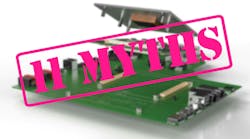11 Myths About the COM-HPC Computer-On-Module Standard
What you’ll learn:
- What is COM-HPC?
- What are COM-HPC’s capabilities?
- How is COM-HPC used?
Addressing applications that require high performance and scalability, PICMG’s COM-HPC is often found in industrial automation, telecommunications, medical devices, embedded systems, edge computing, automotive, consumer electronics, as well as aerospace and defense applications.
These types of applications generally require rugged, robust computing power that can manage complex processes, real-time data processing, and high-speed data transmission like 100G Ethernet. A reduction in latency and bandwidth is critical as are rich I/O interfaces and support for accelerated AI functionality. This is precisely what’s handled by COM-HPC.
As COM-HPC has evolved, some misconceptions about its functionality and applicability in the embedded computing industry have also taken shape. Here, we bring to light the facts surrounding this essential open standard.
1. COM-HPC is a replacement for COM Express.
COM-HPC is not a replacement for COM Express; rather, it builds on its foundation. It addresses the needs of the growing demand for high-performance computing and is designed with more advanced features that go beyond what COM Express can support.
Several differences set COM-HPC apart from COM Express, including performance (i.e., support for PCIe 6.0), advanced form-factor and connector designs, extensive I/O options, as well as enhanced thermal, power, and platform management. COM-HPC is a more performance-dense alternative designed to accommodate next-generation use cases like AI acceleration, rugged edge servers, and high-bandwidth networking.
The increased memory capacity, larger module sizes that allow for greater thermal dissipation, and support for server-class processors (up to 358-W TDP for the server module) suit it for applications that require greater computing power.
Meanwhile, COM Express remains a viable option for balanced, mid-range performance-per-watt (PPW) applications in far edge deployments.
Both COM-HPC and COM Express share the modular approach to computing. However, COM-HPC is designed to meet the needs of modern, high-performance applications requiring more advanced capabilities.
2. COM-HPC is designed for server/data-center uses only.
Although the COM-HPC server type is primarily designed for demanding, high-performance applications, offering features like high-speed computing, extensive I/O capabilities, and advanced thermal management, it’s not limited to just server/data use.
COM-HPC also defines Client and Mini types, which can be used in embedded systems that require “non-server” processing power, like those used in industrial automation, robotics, and advanced medical devices. It can also be utilized for edge-computing applications, such as radar systems, medical imaging, on-premises telecommunications, and rugged edge servers.
The high-performance capabilities of COM-HPC are excellent for workstations that require a great deal of processing power, as well as medical imaging and video processing, broadcasting control room applications, and industrial real-time multi-axis motion control.
Network and communication equipment benefit from the advanced features offered by COM-HPC because it enables faster data processing and an extremely efficient way to manage network traffic. Research and development can also gain an advantage from the custom high-performance computing and flexibility that’s required for complex data analysis, including AI algorithms.
With new form factors like the COM-HPC Mini, released in 2023, and compatibility with power-efficient processors, COM-HPC is poised to provide a forward migration path for more deployable embedded applications currently serviced by COM Express (e.g., edge control, human-machine interfaces or HMIs, drones, and more).
3. The COM-HPC specification requires x86 processors/CPUs.
The COM-HPC specification was designed for heterogeneous processor architectures. This includes not only x86 CPUs from Intel and AMD, but also other architectures like high-performance Arm, dedicated GPUs, and flexible FPGAs to support specialized use cases in embedded systems and edge computing.
COM-HPC can also support XPU/GPU topologies for emerging AI use cases while FPGAs open new doors for I/O processing and acceleration at the intelligent edge. Its modular nature allows for flexibility in choosing the right compute engine to meet the requirements of a particular system. It’s even possible to use several different architectures in a single design based on PCIe interconnects to create truly heterogeneous solutions.
4. COM-HPC is expensive.
Although it may seem to have a high barrier of entry, COM-HPC offers users more, including increased computational power, higher data throughput, double the number of I/O interfaces, as well as advanced thermal management.
COM-HPC provides scalable price and performance, offering the processing performance for today, yet scalable for future generations. PCIe 5.0 and 6.0 connectivity and other features of bleeding-edge processors are also supported.
The two-board computer-on-module architecture, which includes a standardized compute module and customizable carrier board with high-speed signaling between them, provides a cost-effective prototype to production platform. In addition, engineers can develop application-specific functionality that meets today’s needs while easily scaling to future performance levels without a complete system redesign.
5. COM-HPC focuses on single-module use cases.
COM-HPC is designed to support a wide range of use cases, not just single-module situations. It defines the possibility to connect multiple modules via PCIe lanes to allow for heterogenous, multi-module system solutions. Its focus is to provide scalable, high-performance computing solutions.
COM-HPC can also be used in a variety of configurations depending on the requirements of the application. Versatility is one of the strengths of the COM-HPC standard.
6. Thermal management on COM-HPC is challenging.
As with any system that requires high-performance and increased power requirements, thermal management can be complex, but it doesn’t need to be challenging. There are a variety of ways to address thermal management within such systems and manage the heat generated by high-performance components. These include advanced cooling solutions like high-efficiency heatsinks, active cooling with fans, liquid-cooling systems, as well as heat pipes that help with dissipation on 150-W TDP processors and 350-W-plus power budgets.
By following manufacturer guidelines for thermal management and cooling solutions that are specific to COM-HPC modules, along with careful planning and the use of appropriate cooling solutions, thermal management can be effectively addressed.
Following the COM-HPC specification, the system’s cooling interface is standardized. Module upgrades or module vendor changes don’t require a system redesign.
7. COM-HPC only supports current-generation processor technology.
The COM-HPC modules available today are all based on current processor technologies. These CPUs can’t yet fully exploit the possibilities of COM-HPC. Future modules, based on future silicon, will provide more performance and I/O possibilities without breaking backwards compatibility. Choosing COM-HPC today provides the best security of your investment based on its clear upgrade path for future technology.
8. COM-HPC is only for high-power, high-performance applications.
COM-HPC is a very versatile platform with power, performance, and workload possibilities that span from edge to cloud. Although primarily designed for high-performance, high-power applications in demanding environments, COM-HPC isn’t limited to these use cases.
Because of its flexibility, it can be adapted to various applications that benefit from its advanced capabilities. Among them are:
- High-performance edge-computing devices in smart factories or industrial environments
- Advanced medical imaging and diagnostic equipment that needs high processing power to function
- High-speed data processing and connectivity for telecommunications equipment
COM-HPC provides future-proofed power and connectivity to anticipate future needs.
The new COM-HPC Mini targets legacy embedded applications by supporting CAN, SGMII, and I2C. It can adjust many I/O voltage rails from 3.3 to 1.8 V for lower power consumption and increased efficiency.
With the COM-HPC Mini definition, it’s possible to scale COM-HPC solutions down for small, compact, and power-saving mobile applications—with scalable performance.
9. COM-HPC can’t be ruggedized.
COM-HPC modules can be ruggedized to withstand harsh environments. They’re designed for edge use cases. While COM-HPC specifications themselves don’t dictate ruggedization, manufacturers can design and produce ruggedized versions of these modules to meet specific industry standards.
Furthermore, COM-HPC Mini is rugged by design. It includes soldered memory that resists shock and vibration and provides efficient cooling. Similarly, a COM-HPC Server module is used in rugged servers for field environments, such as autonomous vehicles, cell tower base stations, and defense systems. Some modules are designed to operate at an extended temperature range. This helps create rugged edge devices for outdoor use cases without the need for climate-controlled cabinets.
10. COM-HPC has limited scalability.
COM-HPC offers exceptional scalability, with a range of performance levels that can support a large variety of high-performance processors, including those from Intel and AMD. It can also accommodate different levels of computing power depending on the specific module and processor used.
In addition, the standard specifies modular design principles, allowing for easy upgrades and changes in computing power by swapping out the module, making it easier to scale systems up or down based on performance needs.
On top of that, it offers several different form factors, while catering to different application needs and space constraints. This allows for flexibility in designing scalable systems, including:
- COM-HPC Server: Targets headless (no display) embedded servers that require intensive CPU performance, large memory capacity, high-bandwidth I/O, and platform management for remote operation.
- COM-HPC Client: Used in high-end embedded client products that need one or more displays; a full set of low-, medium-, and very-high-bandwidth I/O; powerful CPUs; and a modest form factor.
- COM-HPC Mini: Provides a dense small form factor with high-performance protocols for traditional embedded and mobile computing applications.
11. COM-HPC isn’t capable of AI acceleration.
COM-HPC supports AI acceleration through the specific modules and compute engines used as well as the overall system design. The specific hardware, system configuration, and availability of appropriate software and drivers also contribute to enabling AI capabilities in a COM-HPC system.
The modern processors from all silicon vendors used in COM-HPC have more and more integrated AI acceleration features. Some COM-HPC modules come with integrated GPUs and NPUs (neural processing units), which are useful for parallel processing and help with AI tasks.
For more intense AI workloads, COM-HPC modules can be paired with discrete GPUs or specialized AI accelerators, or other AI-focused hardware, and integrated using the module’s expansion interfaces. AI acceleration modules can also be implemented as COM-HPC modules, which allows for a very rugged system design with extremely fast interconnects up to PCIe 6.0.


